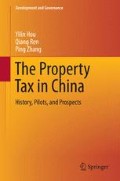Abstract
The revelation of true preferences of the quality and quantity of key public services, the efficiency in providing these services by local governments, and the accountability of local officials to tax payers have long been a critical issue in the study of governance, political economy, public finance, and public administration. The real property tax as a local own-source revenue at the discretion of localities has served as the link among these issues in western countries, the USA being an example. Despite many advantages this revenue source has rendered, financing basic public services with the property tax has led to equity issues, which is why the financing responsibility in the USA has tended to move up, or centralize, to higher levels, education being a typical example.
Access this chapter
Tax calculation will be finalised at checkout
Purchases are for personal use only
Notes
- 1.
There are some changes in names or codes in districts or counties; to keep the consistency, we convert them into the most recent ones. In Wuhan of Hubei, there are no counties; two districts were selected. In Hainan, Xizang, Qinghai, and Xinjiang, two counties were selected from prefectural cities because there are no urban districts.
- 2.
First of all, for each province we calculate the real changes of living space from 2000 to 2010 by R2010 − R2000 (from Population Censuses), and sum up the sales data from 2001 to 2010 [sum(S2001:S2010), from China Statistical Yearbook series]. Then we can calculate revised sales data by the formula (take 2005 as example): revised Sale2005 = S2005*(R2010 − R2000)/sum(S2001:S2010). We made this calculation for each province and year. The same revision applies to sales data of villa and subsidized houses which we will do in the next step.
- 3.
All data used for calculation in this part are in per capita provincial average.
- 4.
The population of cities and townships are combined together in each year’s China Statistical Yearbook.
- 5.
The formula is (1+x)10=S2010/S2000, based on the per capita living space in 2000 and 2010, we can calculate x for each province. The rationale is that even though total available living space increases more quickly with new construction, the total urban population also increases pretty fast in the same period. Table 9.1 indicates that at the national level the total living space doubled while the per capita level increased only about 50 %. Thus, we argue that this formula can generate the closest estimation to the real situation.
- 6.
Source: China Statistical Yearbook 2011, Schedule 10–2. The figures are in RMB or Yuan.
- 7.
Source: China Statistical Yearbook 2011, Schedule 10–1, 3–5, 20–38; China’s Education Statistical Yearbook 2010, 4495.
- 8.
- 9.
Source: China Statistical Yearbook 2011, 10–5. The rural area has the same trend, but the number of people per household decreases more slightly. They are 4.80, 4.20, and 3.85 in the three years (from ibid, 10–18).
- 10.
This amount here is smaller than per capita revenue which is about 9000, because part of total expenditure is “upward transfer” (to higher level government) which is an established institution in China. The same applies to nonmetro urban districts and counties. However, the amount or proportion of “upward transfer” for nonmetro urban districts is smaller with counties as the smallest.
- 11.
This ratio would have been the same whether we use per capita or per household figures.
- 12.
The lower ratios are mainly in western area, while the lowest ratios in eastern area are around 10 %.
Author information
Authors and Affiliations
Corresponding author
Rights and permissions
Copyright information
© 2015 Springer International Publishing Switzerland
About this chapter
Cite this chapter
Hou, Y., Ren, Q., Zhang, P. (2015). Simulation. In: The Property Tax in China. Development and Governance, vol 1. Springer, Cham. https://doi.org/10.1007/978-3-319-10049-4_9
Download citation
DOI: https://doi.org/10.1007/978-3-319-10049-4_9
Published:
Publisher Name: Springer, Cham
Print ISBN: 978-3-319-10048-7
Online ISBN: 978-3-319-10049-4
eBook Packages: Business and EconomicsEconomics and Finance (R0)

